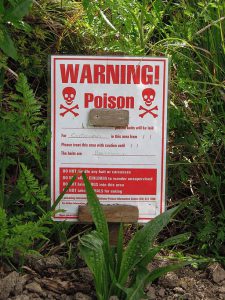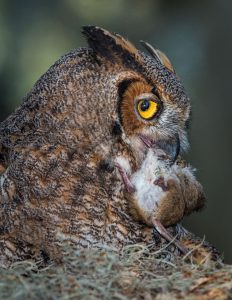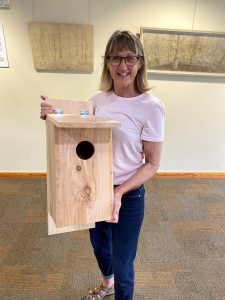Want this information on-the-go? Check out this episode from the “Naturally Florida” podcast.
I’d be willing to bet if I asked a room full of people to raise their hands if they like rodents, and then asked them same about owls, we would see a stark difference. I’d also be willing to bet you would much rather have owls in your yard than rodents. Here’s the issue though, many owls need rodents to survive. The further issue? In our effort to control rodents, we can indirectly be harming owls, and other birds of prey and mammals too.
Here’s how…
One method of control for mice and rats is the use of ingestible anticoagulant (blood thinner) rodenticides (literally “rodent killers”) that can take several days to cause death. Predators that consume these poisoned rats and mice, either while they are still alive or even once they’ve died, can then become exposed themselves. We call this secondary exposure. There are other forms of rodenticides that are lethal within hours of consumption, but for today we will focus on anticoagulant rodenticides.

Rodenticide – a poison used to kill rodents.
It’s no secret that we recently had several cases of owls dying in our local parks, and necropsy results confirmed their deaths were due to rodenticide poisoning. Following the death of the famous great-horned owls at Philippe Park, I received several emails and phone calls inquiring about the availability of “bird-friendly” rodenticides. The short answer is they don’t exist. The longer answer is there are bird-friendlier rodenticides and options where rodenticides don’t have to be used at all.
Rodenticides
It’s important to know and understand how rodenticides work…which in itself might make you less likely to use them.
Rodenticides are preferred by many people because it doesn’t require you to interact with the rats like a snap trap would. Again, I am going to focus on anticoagulant rodenticides as these have been the cause of the owl deaths we have seen recently in Pinellas County.
There are two types of anticoagulants: first-generation and second-generation.
First-generation anticoagulant rodenticides (FGARs) are available to the public, but second-generation anticoagulant rodenticides (SGARs) are only available commercially. Let me break these down real quick, then we will get into how they work.
- FGARs are a lower-dose poison, requiring target species to consume multiple doses to result in death. These poisons break down quicker in the body, and therefore present less risk of predators being exposed.
- SGARs were developed due to mice and rats building a resistance to the lower dose FGARs. So, SGARs are designed to be lethal with just a single dose. Chemicals within SGARs remain in body tissue for months.
Due to the nature of how SGARs work, they are more likely to cause secondary exposure and will be the focus from here on out.
How SGARs Work
Rodents consume the anticoagulant rodenticide, they continue with their day, then later, sometimes days later, they begin to feel sick. If they consumed enough poison, they will die from internal bleeding.
Predators that consume multiple poisoned rodents may suffer from something called bioaccumulation, where the small amounts of rodenticide in the poisoned rats or mice will build up in their system and can lead to the death of the predator (secondary poisoning). Death can also result from the consumption of only one exposed rat.
What to do?
Just like our recommendation for gardening with integrated pest management, we encourage the least toxic options to be tried first before resorting to chemicals (such as rodenticides). If you’re having issues with rodents, try these measures:
- Rodent proofing – This involves making alterations to building structures to block off entryways using rodent-resistant materials.
- Keeping clean – Removing any unnecessary food, water and shelter sources for rats including garbage, pet food, bird feed, and fallen fruits. This helps with numerous other potential wildlife conflicts too!
- Supporting predators –By supporting predators of rats and mice such as hawks, owls, coyotes, and snakes, you can support predations of rats and mice without the use of pesticides. You can think of these predators like live rat traps. Okay, don’t panic, I know I just said you should welcome snakes and coyotes to your yard. Coyotes love to prey upon small mammals; in fact, they make up 31% of their diet! Our commonly encountered non-venomous neighborhood snakes like black racers and rat snakes are quite fond of rodents too. And if you’ve ever dissected an owl pellet, you know how much they like rodents. The most studied owls in terms of diet is probably the barn owl; it’s been documented that a nesting pair of barn owls can consume over 3,000 rodents in just one year!
- Trapping – Traps are safe and effective, but they are not one-size-fits-all. There are many different types of traps that kill rodents humanely. The most affordable option are snap traps, but costlier alternatives encase the killing mechanism in a box, so you don’t have to interact with the dead rat or mouse. Other alternatives, like glue boards are not humane because they prolong death. If you want to go this route, I encourage you to read this blog to ensure you are doing it right. Traps can capture non-target wildlife, so while cheap and effective, they too can pose threats to other wildlife.
- Using poison baits – This should be used as a last resort if the other methods above are not effective. Be sure to read the label to ensure the rodenticide you are using is designed for the species you are targeting, and that you follow instructions for correct usage and application. You can also consider hiring an extermination company to conduct rat and mouse control.
For more information on rodenticides, check out this publication from UF/IFAS.
Finally, remember that house cats and dogs, even though not very frequent, can also be affected by eating poisoned rats or mice, or by directly eating the bait. If you suspect your pet could have been exposed to or eaten a rodenticide bait, contact your veterinarian as soon as possible. Remember, many rodenticides are available, with different formulations, colors, and shapes. For an effective treatment, the veterinarian needs to identify the active ingredient, which can’t be determined just from the color or shape of the bait. If the rodenticide package is available, give that information to your vet. Here are some links that can help if you think your pest was exposed to rodenticides or toxics.
- https://floridapoisoncontrol.org/prevention/home-safety/for-animals/
- https://www.aspca.org/pet-care/animal-poison-control
Thank you for caring about our area wildlife. We have tons of resources available on our YouTube Channel if you wish to learn more on-demand.
Sources:
-
Secondary poisoning of owls by anticoagulant rodenticides by Vivian M. Mendenhall and L. F. Pank
-
Pesticide Toxicity Profile: Coumarin and Indandione Rodenticides by Frederick M. Fishel
-
Pesticide Toxicity Profile: Miscellaneous Rodenticides by Frederick M. Fishel
-
Rat and Mouse Control by P. G. Koehler and W. H. Kern Jr.
-
National Pesticide Information Center – Rodenticides – Topic Fact Sheet
-
Rodenticides in British Barn Owls
-
Anticoagulant Rodenticides in Three Owl Species from Western Canada, 1988–2003 | SpringerLink
-
https://www.fluoridealert.org/wp-content/pesticides/EPA-HQ-OPP-2006-0955-0005.pdf
 0
0


